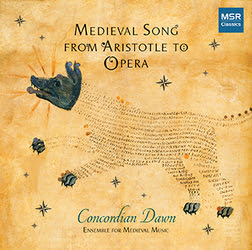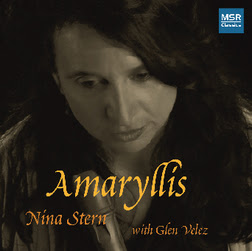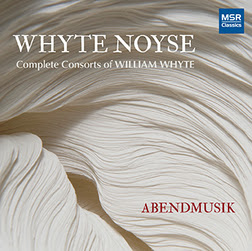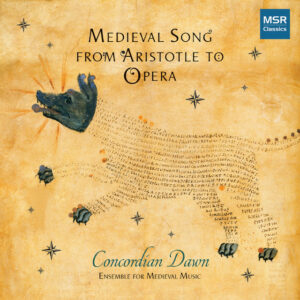Program: #24-15 Air Date: Apr 08, 2024
To listen to this show, you must first LOG IN. If you have already logged in, but you are still seeing this message, please SUBSCRIBE or UPGRADE your subscriber level today.
Medieval Song part 2 with Concordia Dawn, the consorts of William White, and a medieval and renaissance reflection with Nina Stern and Glen Velez.
I. Medieval Song from Aristotle to Opera, Vol. 2 (Concordia Dawn). MSR CD MS 1806.

Medieval Song from Aristotle to Opera is the title of an interdisciplinary publication and recording project by Sarah Kay and Concordian Dawn that focuses on medieval French and Occitan troubadour and trouvère song, inset lyrics in narratives such as those of Guillaume de Machaut, and selected polyphonic songs and motets. This album represents a portion of the fruits of this collaboration, bringing some of the musical recordings to a wider audience.
Our collaboration explores what Kay terms “ecologies” of song and the distinctive voices they give rise to. On this CD you can hear the singing of the stars and sun in the dawn sky (“Phoebi claro”); voices that sing with breath inhaled from―or inspired by―celestial beasts, as their spirit filters down to the earth (“Ensement com la panthere”); song provoked by the touch of personified, abstract presences (“Tieus rit au main,” “Joie, plaisance,” and “En amer” from Le Remede de Fortune); singing that emanates from the singer’s immediate natural surroundings and draws connections between voice, air, life or death, and the soul (“Can lo boschatges,” “Entre.l Taur”); the seductive-yet-lethal sound of the Siren, audible in the quasi-muse-like, flute-and-harp playing half-human-half-beast who sings, but whose song is never exactly recorded or notated (“Volez vous,” “Joie, plaisance,” In virtute/Decens/Clamor); and the sound of internalized song that is as much (if not more) imagined and desired as it is heard (“Nés qu’on porroit”). Kay describes this method of approaching these songs as “operatic reading” because she wants to emphasize the multimedia, multisensory nature of their performance and manuscript transmission. She does not use “operatic” to mean a performance style and the term has no qualitative bearing on vocal timbre or production. Instead, it aims to integrate the songs to specific audio-visual (and even tactile) environments. Imagining the sound of medieval song involves a continual negotiation with loss and discovery. The original sound of medieval song, as we know, is forever lost to us. Even if we knew exactly how it would have sounded those many centuries ago, our historical distance prohibits us from perceiving it in the same way that one would have then, and it will never enter our consciousness and “inspire” us as it would have a medieval listener. Yet, reimagining its sound world in an effort to discover what medieval song might have sounded like does inspire us in its own right, little by little bringing us closer to an adequate realization of our own place in time. As Kay observes, “unconfined to its time, de-realized, displaced, and remade in imagination, medieval song will continue being recreated and heard where it is not”. Our reinterpretation of these songs participates in this process of discovery and loss in an effort to imagine how the songs might have sounded in the Middle Ages, knowing all the while we will never recapture the medieval soundscape. The whole process is a thought project that begins with the anticipation of losing while hoping to find glimpses of medieval soundbites.
Anonymous (11th century) | I-Vb Vat. Lat. 1462, fol. 50v
(melody reconstructed by Christopher Preston Thompson)
Phebi claro nondum orto iubare (Alba of Fleury-sur-Loire)
Philippe de Vitry (1291-1361) | F-Pn NAL 2444, 48r
In virtute nominum / Decens carmen edere / Clamor meus
Guillaume de Machaut (1300-1377) | Machaut MS C, F-Pn fr. 1586, 39r
Joie, plaisance, et douce nourriture (Chant royale from Le Remede de Fortune)
Anonymous (troubadour, 13th century) | F-Pn fonds fr. 844, 199v
Ensement com la panthere
Anonymous (trouvère, 13th century) | F-Pa fonds fr. 5198, 314
Volez vous que je vous chant?
Guillaume de Machaut | Machaut MS E, F-Pn fr. 9221, 178r-v
Nés qu’on porroit (Ballade from Le Livre du Voir dit)
Guillaume de Machaut | Machaut MS C, F-Pn fr. 1586, 30r
Tieus rit au main qui au soire pleure (Complainte from Le Remede de Fortune)
Bernart de Ventadorn (troubadour, fl. 1147-1180) | PC 70.40 (text); I-Ma R71 sup., 19r (melody)
Can lo boschatges es floritz” (melody borrowed from Bernart’s “En consirer et en esmai”)
Raimon Vidal (troubadour, 1196-1252) | Arnaut Daniel (troubadour, fl. 1180-1200)
Bertran de Born (troubadour, fl. 1175-1200) | Monge de Montaudan (troubadour, 1193-1210) (text attributed variously to Vidal and Daniel, PC 411.3; melody from Bertran’s “Rassa tan creis”) (F-Pn fonds fr. 22543, 6v) via the Monge’s “Mot m’enveya” (F-Pn fonds fr. 22543, 40r)
Entre.l Taur e.l Doble Signe
Guillaume de Machaut | Machaut MS C, F-Pn fr. 1586, 46r
En amer a douce vie (balladelle from Le Remede de Fortune)
II. Amaryllis (Nina Stern./Glen Velez). MSR CD MS 1577.

NINA STERN
Renaissance tenor recorder in C (Thomas Prescott); Virdung” tenor recorder in C (Adrian Brown); Cylindrical alto recorder in G (Bob Marvin); Alto chalumeau in C (Agnès Géroult); Ganassi” alto recorder in G (Frederick Morgan); Ganassi” soprano recorder in C (Shigeharu Hirao-Yamaoka); Alto recorder in F, after Debey (Frederick Morgan)
GLEN VELEZ
Sruti Box; Eckermann Turkish Drum / Bruno Spana Tamburello; Strumstick; 20” Cooperman Bodhran; 15” Cooperman Gaval; 8” Cooperman Mediterrasian; Tambourine; 17” Cooperman Tar; Contemporanea Surdo Frame Drum
This disc represents a musical landscape – a personal collection of some of my favorite pieces of music. The range is wide, from the Medieval to the Baroque, from instrumental to vocal, from music originally written for recorder to arrangements and adaptations. The works Sirt im Sasani, Bloubli Hid, Aravod Luso, Diba u Yengidunia, and the theme of Amarilli mia bella were all originally written for voice. It was not uncommon for instrumentalists to perform their own versions of celebrated vocal works. The recorder, according to Silvestro Ganassi - a member of the official wind band of the Venetian state and author of the important treatise La Fontegara (1535) - is an instrument that can come close to the sound of the human voice. “Only the form of the human body is absent” he writes. “It is possible, with some players to perceive, as it were, words to their music.” The instrumental works range from pieces written specifically for recorder (the four works by Jacob van Eyck and Greensleeves) to those written for an unspecified single melody instrument (Lamento di Tristano / La Rotta and Chominciamento di Gioia) to Telemann’s Fantasia No.8, which was originally composed for flute.
ARAKEL SIUNETSI (ca.1355-1425)
Sirt Im Sasani (My Heart Trembles)
ANONYMOUS (Italian, 14th century)
Lamento di Tristano (Tristan’s Lament) / La Rotta
NERSES SHNORHALI (12th century)
Aravod Luso (Bright Morning)
ANONYMOUS (Italian, 14th century)
Chominciamento di Gioia (Joy’s Beginning)
SAYAT NOVA (1712-95)
Bloubli Hid (With the Nightingale)
Diba u Yengidunia (Silk and Muslin)
JACOB VAN EYCK (c.1590-1657)
Amarilli mia bella (Amaryllis, my lovely one)
Praeludium of Voorspel (Preludium or Prelude)
Prins Robberts Masco (Prince Robert’s Masque)
De Frans Courant (The French Courante)
GEORG PHILIPP TELEMANN (1681-1767)
Fantasia No.8 in G minor, TWV 40:9
ANONYMOUS (The Division Flute, 1706)
Greensleeves
III. Whyte Noyse (Abendmusik) MSR CD MS 1840.

The Jacobean (1603-1625) and Caroline (1625-1649) periods are perhaps the most culturally prolific in English music history. The contributions by composers were extraordinarily rich, and provided the church, court and countryside with, among others, voice anthems, consort songs and instrumental consorts or fantasies. Composers, such as William Byrd, Giovanni Coprario, Alfonso Ferrabosco II, Orlando Gibbons, Thomas Lupo, Thomas Tomkins, John Ward and William Whyte were principal contributors to all three genres and represented a major musical dynasty in the employ of Charles I (1600-1649).
Very little is known about William Whyte’s background. Although he composed a few anthems, only 14 instrumental consorts for viols (in two, three, five and six parts) are extant and can be found in several late-Jacobean and Caroline sources. We know that he appears in records in 1603 as a “singing man at Westminster” and was paid to participate in Queen Elizabeth’s funeral that same year. Whyte is represented among 225 compositions which appear in the 1616 part books of Thomas Myriell’s Tristitiae remedium. Cantiones selectissimae, diversorum tum authorum, tum argumentorum; labore et manu exaratae. Based on the dating of the sources in which his consorts appear (the latest being Oxford. Christ Church MSS 61-66) it is believed that his most prolific phase may have been around 1620, at the height of the Jacobean period. Whyte is mentioned in Thomas Mace’s Musick’s Monument (1676) among composers of “very Great Eminency, and Worth,” in John Playford’s “Musick’s Recreation” (1652) and in Christopher Simpson’s “A Compendium of Practical Music” (1667).
Although we know little about him, there is no doubt that Whyte was well-respected by his peers. Thomas Tomkins dedicated his madrigal, “Adieu ye city-prisoning towers,” to Whyte in his “Songs of 3, 4, 5 and 6 Parts” (1622). The madrigal contains hockets, perhaps as an homage to Whyte as he employs the same device in his Fantasia No.6 in 6 parts or perhaps Tomkins’ dedication may have influenced Whyte to incorporate the technique in his fantasia as an acknowledgement of Tomkins. Although hocket was a well-known vocal device, its appearance in instrumental music was rare. Whyte’s consorts are also characterized by a pervasive use of instrumental writing in pairs, bincina style. As a result, Whyte is considered adept at the art of imitation and creating various textures and moods. At times he creates a vivid musical dialogue in which a variety of emotions are musically brought to life, an important element of consort style summed up by Roger North in his essay, “On Music.”
“My thoughts are first in general that music is a true pantomime or resemblance of Humanity in all its states, actions, passions and affections. And in every musical attempt reasonably designed, Humane Nature is the subject...so that an hearer shall put himself into the same condition, as if the state represented were his own.... So the melody should be referred to [man’s] thoughts and affections. And an artist is to consider what manner of expression men would use on certain occasions, and let his melody, as near as may be, resemble that.” [Quoted in John Wilson, Roger North on Music (London: Novello, 1959), 110ff.]
Not only are pairings of instruments commonplace in Whyte’s fantasies, quotes from popular melodies or melodies associated with his contemporaries appear as well, perhaps subtle hints as to his working environment and who he may have known. For example, his Fantasia No.4 for 6 viols is a nod to William Byrd in a reference to a melodic motive from one of Byrd’s 6-part fantasies.
With regard to the orchestration of fantasias during this period, that being whether the music was played on an entire consort of viols or a mixture of violins and viols, we know that Prince Henry and Prince Charles were dedicated amateur musicians and employed both violinists and viol players in a royal household known for its string consort music activities. Coprario, Ferrabosco II, Lupo and Gibbons were among the chief composers who were members of the royal ensemble known as “Coprario’s Musique.” John Woodington and Thomas Lupo were among the violinists employed at court and in fact Thomas Lupo was acknowledged formally as “Composer for the violins.” Although today we favor the use of a chest of viols as a standard bearer of English consorts, we must recognize that a mixed instrumental ensemble was highly probable given the activity in the royal household and the knowledge that some composers specified violin in compositions featuring a treble, bass viol and keyboard part in the latter part of the period.
Without placing too much emphasis on historical orchestration and speculation, it is most important, nevertheless, that the execution of the music reflect the beauty, sentiment, and intention for which it was created.
“With respect to amusement, and relief of an active mind distressed either with too much, or too little employment, nothing under the sun hath that virtue, as a solitary application to music. It is a medicine without any nausea or bitter, and is taken both for pleasure and cure.” [Wilson, 257ff.]
Patricia Ann Neely [April 2023]
PROGRAM
WILLIAM WHYTE (1571-1634)
Pavan a 6, No.2
THOMAS TOMKINS (1572-1656)
Galliard a 6, No.92
WILLIAM WHYTE
Fantasia a 6, No.1
Fantasia a 5, No.2
Fantasia a 3, No.14
Fantasia a 6, No.3
Fantasia a 2, No.1
Pavan a 6, No.1
Fantasia a 6, No.5
Fantasia a 5, No.3
Fantasia a 2, No.2
Fantasia a 6, No.2
Fantasia a 6, No.6
Fantasia a 5, No.1 “Diapente”
Fantasia a 6, No.4
Composer Info
Philippe de Vitry (1291-1361), Guillaume de Machaut (1300-1377), Bernart de Ventadorn (troubadour, fl. 1147-1180), Raimon Vidal (troubadour, 1196-1252), Arnaut Daniel (troubadour, fl. 1180-1200), Bertran de Born (troubadour, fl. 1175-1200), Monge de Montaudan (troubadour, 1193-1210), Arakel Siunetsi (ca.1355-1425), Nerses Shnorhali (12th century), Sayat Nova (1712-95), Jacob Van Eyck (c.1590-1657), Georg Philipp Telemann (1681-1767), William Whyte (1571-1634).
CD Info
MSR CD MS 1806, MSR CD MS 1577, MSR CD MS 1840
